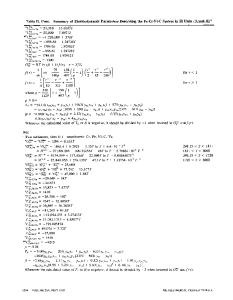Thermodynamic assessment of the Mn-O system
- PDF / 727,881 Bytes
- 11 Pages / 603.28 x 783.28 pts Page_size
- 46 Downloads / 485 Views
I.
INTRODUCTION
THE phase diagram of the Mn-O system was recently evaluated by Massalski et al.,ll] mainly based on the reported information of Trrmel et al. t21 and Chen. I31 The system exhibits a wide liquid miscibility gap on the Mn-Mnl_xO side and an eutectic point on the Mnl_xO-Mn304 side. t1-41 The manganosite (Mnl_xO) is a nonstoichiometric compound with a deficit of Mn. The reported experimental information on the phase diagram is rather scarce and imprecise. However, many thermodynamic investigations have been reported in the literature dealing with various aspects of pure manganese and manganese oxides. The purpose of the present assessment is to obtain a set of revised thermodynamic descriptions of various phases and a thermodynamically consistent phase diagram of the Mn-O system based on the relevant experimental information by means of the CALPHAD technique. II.
EXPERIMENT INFORMATION
The available experimental information on the Mn-O system has been reviewed in the present work. Table I shows the crystal structure data of the solid phases. A . M a n g a n e s e (Mn)
The thermodynamic properties of condensed manganese have been compiled several times. I5 101The most recent result by Guillermet et al. I1~ was adopted in the present assessment. B. M a n g a n o s i t e (Mnl_xO)
Manganosite is a nonstoichiometric compound with the halite type of crystal structure. The oxygen activity has been measured by several authors, tl~-laj but the deviations among these results are large. Bransky and Tallan t~31measured the excess oxygen in Mnj_xO in the temperature range of 1273 to 1773 K and at oxygen pressures of 10 -14 to 1 atm by the thermogravimetric method. However, the excess oxygen that they measured is rather MINGSHENG WANG, formerly Research Associate, Royal Institute of Technology, Stockholm, Sweden, is Lecturer, on leave from the Department of Metallurgical Engineering, Baotou Institute of Iron and Steel Technology, Baotou, People's Republic of China. BO SUNDMAN, Docent of Physical Metallurgy, is with the Division of Physical Metallurgy, Royal Institute of Technology, S-100 44 Stockholm, Sweden. Manuscript submitted May 4, 1992. METALLURGICALTRANSACTIONS B
small, especially at the temperatures of 1273 and 1373 K. This may be due to an incorrect assumption regarding the evaporation rate of manganosite during the experiment. Janowski et al. [14] also studied the excess oxygen by the same method, but the calculated oxygen pressure of the gas phase was too low to keep the manganosite thermodynamically stable. Davies and Richardsontl q studied the excess oxygen of manganosite by analyzing the composition of the samples quenched from a certain temperature and oxygen pressure. The experimental data are probably rather imprecise, because they found that oxygen pressure in equilibrium with manganosite only varies with the oxygen composition of manganosite but does not change with temperature from 1773 to 1923 K. In 1974, Picard and Gerdanian, t12J with an improved thermogravimetric technique, measured the
Data Loading...











